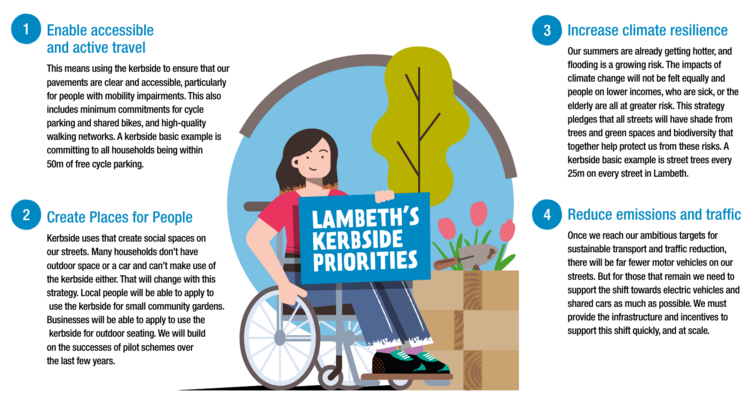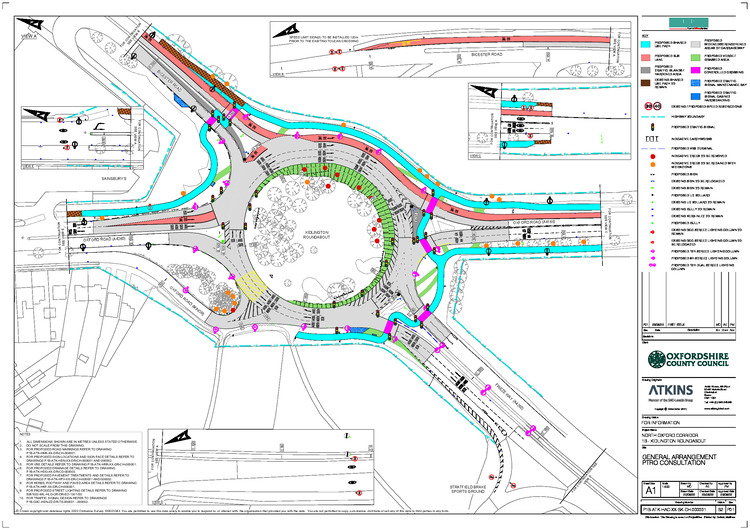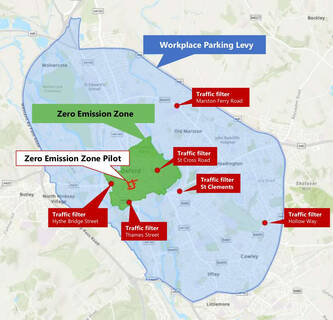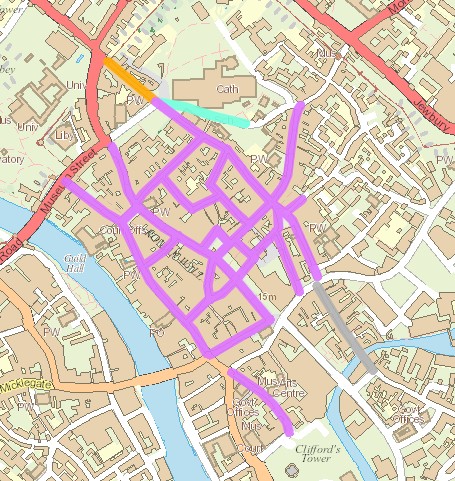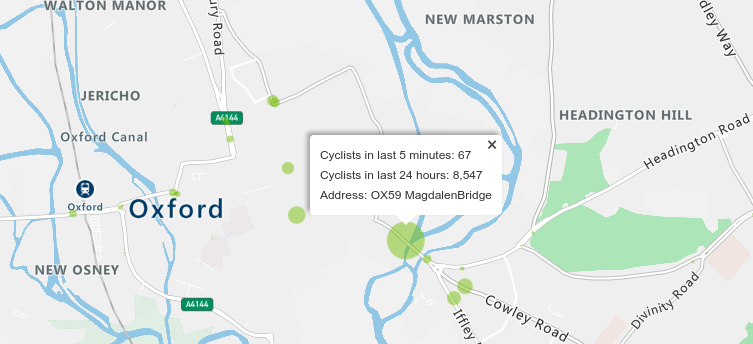There have been concerns about road danger on Barton Fields Rd, the spine road that runs through the Barton Park development on the eastern outskirts of Oxford, in particular around the primary school. One driver ploughed into the cycle parking stands outside the school, another hit one of the buildings under construction on the other side of the street, and there are a lot of other incidents that don't show up in the official road injury record. (There are also concerns about road danger at the crossing of the A40; I have written about those elsewhere.)
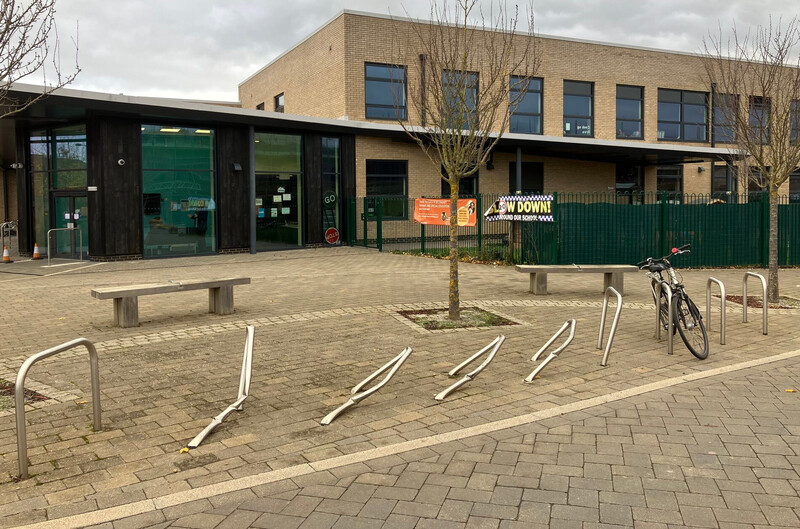
cycle parking stands outside Barton Park Primary School, bent over by being driven into
|
more
"The county should buy a unicorn and stable it on the Plain roundabout, where it will magically stop any collisions, alleviate all congestion, and make walking and cycling safe and accessible to all." This would probably make more sense than some of the transport proposals being bandied about - bus tunnels, removing cycling from main roads, etc. - but here I attempt to address some of the suggestions that seem sensible, but won't do what people want them to do.
Free public transport, segregated cycle tracks, School Streets schemes, traffic calming, Dutch style roundabouts, trams, and so forth are all potentially useful. But they only solve some problems, and in some cases require other measures to make them possible. They are not magically going to obviate the need for traffic removal and reduction - for low traffic neighbourhoods and measures such as traffic filters and the Zero Emission Zone. more
The legal changes to Broad St have been made permanent, but the current layout is clearly still temporary, in the sense that many of the features of the area no longer reflect its actual use. Most obviously, most of the existing kerbs are now redundant, or in the wrong place, and serve only as a trip hazard.
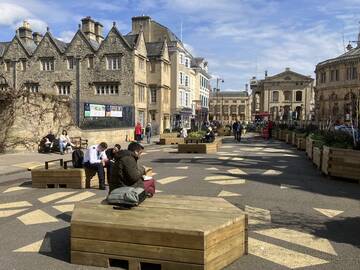
sitting around
A proper plan for Broad St needs to be part of a redesign of the entire area of the city centre north of High St and east of Cornmarket, as envisaged in the Oxford Preservation Trust's proposals twenty years ago, and any such plan will be dependent on funding which is not yet available. But there are possibilities in the management of vehicle access and parking for improvements that could plausibly be implemented in the shorter term. more
At the moment, footways in Oxfordshire fall into the cracks between different county teams. Parking, Road Agreements, Transport Development Control, Active Travel, Maintenance, and different Localities teams all implement or oversee schemes that affect footways, but no one has overall responsibility for them. A single county team should be given responsibility for footways, with a watching brief over all schemes that affect them. That could be a beefed up Active Travel team, or a Parking team with an expanded mandate. more
The Oxfordshire policy on 20mph speed limits says that to be eligible an area must "be within the extent of the built-up environment of the town or village where vulnerable road users and vehicles mix in a frequent and planned manner" and "be in an environment that explains and justifies a lower speed limit to the driver".
A small addition to this would I think make sense. There are sections of road which are not within a built-up area, but which are key walking or cycling links. They may link a village to a bus stop or a strategic cycling route, for example, or an outlying housing cluster (hamlet) to a village centre, or a school to a town centre. Where such sections of road are relatively short and lower speeds would make a significant difference, perhaps because there are no footways or cycling infrastructure, or because crossings are necessary, I think they should be included in the scope of the 20mph policy. more
This outlines a plan for a direct, coherent east-west foot-cycle route across Oxford's city centre. That would run from the railway station across the north of Frideswide Square, along Hythe Bridge St, George St, Broad St, Holywell St, and Longwall St, ending at Magdalen Bridge.
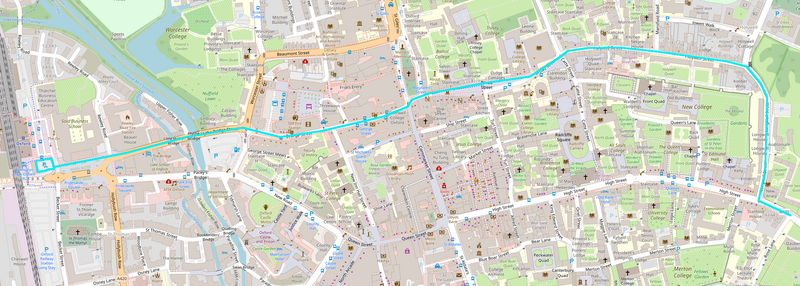 more
more
Fixing all the problems with footways and pedestrian infrastructure across Oxfordshire would involve a huge and expensive program of works, which the county doesn't have the resources for. But we need to stop making things worse — current procedures and processes for new transport schemes and developments and ongoing maintenance are progressively destroying our footways. more
Despite the research, I had always downplayed the psychological and social gains from traffic reduction, thinking of them as secondary to health improvements from increased physical activity - and perhaps as a bit "soft" and hard to measure. But my experience with the East Oxford Low Traffic Neighbourhoods has made me rethink this. more
Deaths and serious injuries — the target of Vision Zero — are just the tip of a much larger iceberg of road danger harm. In addition to the 20 road traffic fatalities and 450 serious injuries in Oxford over the last decade, there were 2800 reported slight injuries (all of those from the STATS19 police database) and (for cycling injuries, across Oxfordshire) ten times as many hospital admissions and attendances (this includes non-collision injuries which are rarely reported to the police). And there will be many minor injuries and collisions which are neither reported to the police nor result in hospital presentations. (Following Ling Felce's death at the Plain, I heard several people make comments like "Oh yes, I've been knocked off my bike twice at the Plain" and "No, I didn't report it either time.") There are even more near-misses and other incidents perceived as threatening. more
Oxford's Lye Valley area has poor walking and cycling connectivity, making it one of the more car dependent areas inside the ring-road (looking at 2011 census commute data). Two key routes could be upgraded to improve this, to the west across Lye Valley to the Churchill Hospital and to the south west over the golf course.
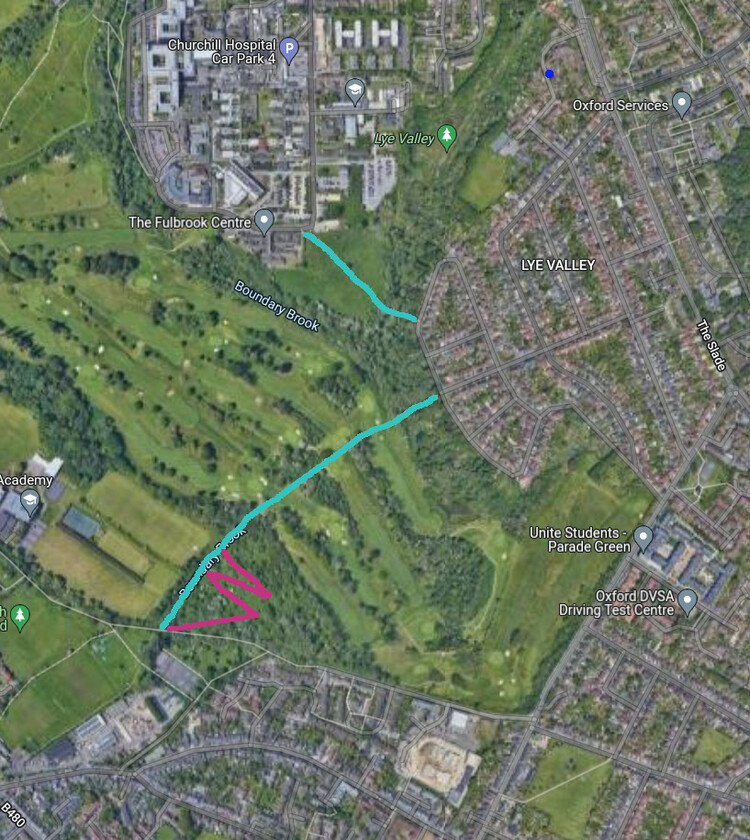
1) Put a proper foot-cycle track, with a bridge, across Lye Brook to the Churchill Hospital. 2) Upgrade the track across the golf course to Barracks Lane to an all-weather foot-cycle track, with a bridge across Boundary Brook to connect to Lye valley and potentially with zig-zags on the descent to Barracks Lane. This would require a legal change from a footpath to a bridleway. The likely form of any track would be a 3 metre wide shared path, with porous surfacing and embedded stud lighting, along the lines of the ones being put in across parks and fields elsewhere (e.g. across King Georges Field).) more
I think consideration should be given to turning off the signals at the northern end of Cornmarket and having that junction operate like the Holywell junction at the other end of Broad St.
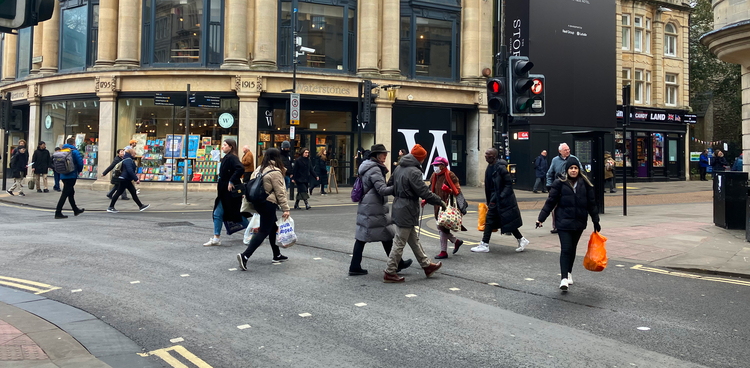
I walk and cycle through this junction regularly, and there's pretty much always:
- a stream of pedestrians crossing on red across George St, as in the photo above - if they didn't they'd pile up and block the footways;
- pedestrians crossing haphazardly across the unsignalled Magdalen St West and Broad St arms, sometimes getting caught out mid-crossing by signal changes;
- mopeds and cycles going through red lights or using the wrong side of the road to turn from Broad St into Magdalen St West; and
- significant periods when buses and taxis and cycles are waiting even though the junction is clear.
more
Lambeth recently released its Kerbside Strategy. This proposes a reallocation of kerbside space towards active travel, place making, climate resilience, and traffic reduction (94% of Lambeth's kerbside is currently devoted to parking or parking restrictions).
more
Wherever possible, space for cycle or scooter parking should be taken from car parking space or spare carriageway space, not from footways or space for pedestrians. Pedestrians are at the very top of the transport hierarchy and private cars at the very bottom.
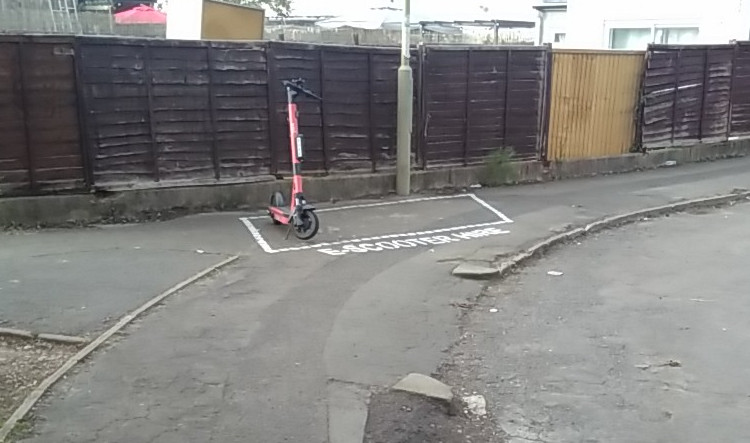 more
more
While the county should continue to support schemes for schools that request them, having that as the only way for schemes to happen will limit the effectiveness of the program. The county should proactively plan School Streets schemes at those locations where they will have the most effect. more
The junction of Longwall St and High St, in Oxford, poses some unusual design challenges. Along with Magdalen Bridge and the Plain roundabout, it is a key bottleneck in Oxford's transport network — this segment is probably the second busiest cycle route in the UK and likely the second busiest bus route. There are huge problems with this junction as it is, but the core schemes in the forthcoming Central Oxfordshire Transport Strategy offer a chance to redesign it.
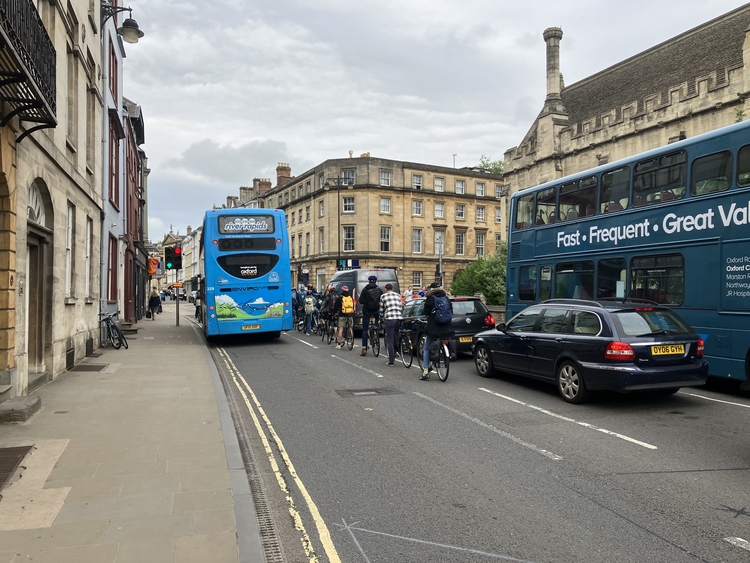
people cycling wanting to turn right into Longwall have to wait in a one metre wide lane with motor traffic on both sides
more
The plans for redesigning the roundabout south of Kidlington are inconsistent with both the county's headline car-trip reduction targets, its active travel goals, and its Vision Zero commitment.
more
How should the planned Oxford traffic filters work: what hours should they operate, what exemptions should there be, and so forth? To understand this, we need to understand their purposes:
- to allow space and time to be reallocated to make walking and cycling safe and accessible, especially at junctions
- to stop buses being congested and delayed, to have better and more efficient bus services
- to free up space (and reduce noise and air pollution) for an improved public realm
But while the goals may be the same, the unique geography of each filter — and the very different roads they are on — means that they may need quite different implementations. This can be illustrated by Hythe Bridge St and Marston Ferry Rd. more
Based on a four day visit to York, I think its city centre should be a model for Oxford's. York has pedestrianised a huge chunk of its centre, and it's really great to walk around. After a bit it just feels entirely normal, just as it does in similarly pedestrianised European cities, and it really shows up just how horrible walking around central Oxford is.
At least during the daytime, outside loading hours, there are no cars at all, moving or parked in the core area of York. This means that one never has to think about traffic at all, or even about getting around parked cars, which makes for a completely different feel to bits of Oxford such as Catte St or Turl St or New Inn Hall St or Merton St or Pembroke St, where anyone walking is likely to encounter at least one moving motor vehicle and many parked ones. more
Oxford's Magdalen Bridge is plausibly the second busiest cycle route and the busiest bus route in the United Kingdom; it is also a major pedestrian route. It is probably the most critical link in the city's transport system.
more
Connecting Oxford is absolutely central to Oxford's transport future. The new county government had been quiet about it until recently, but has made a clear commitment to it in the last few months. It is unclear how much of the details on the old web site are still current, but some of my thoughts on how to prepare for Connecting Oxford follow.
The Local Transport and Connectivity Plan (LTCP) adopted in October 2021 said:
"Work on aspects of Connecting Oxford has already started. The aim is to have the workplace parking levy and traffic filters in place from 2023."
And the lead request for funding in the Bus Services Improvement Plan (BSIP) is for the traffic filters in Connecting Oxford. more







